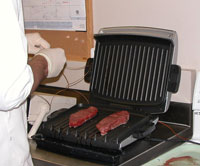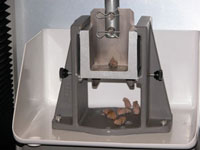Would you pay $345.95 for four 12 oz. strip steaks – raw steaks, mind you, not cooked.
That’s the price on-line for “Kobe-style” strip steaks, as marketed by Allen Brothers – a company some Rush Limbaugh listeners might recognize. That compares to $159.95 for the same quantity of U.S. Prime, dry-aged strip steaks – or just $104.95 for U.S. Prime, not dry-aged. I wonder if Rush buys the Kobe-style? Maybe, maybe not – but somebody buys it and more consumers these days are demanding beef with lots of marbling, despite the health benefits attributed to leaner cuts.
 Dr. Keith Belk, professor at Colorado State University’s Center for Red Meat Quality and Safety, provided that information for the ag editors attending the Elanco Animal Health Sensory Evaluation Briefing this week at ISU. The point he made is that consumers are increasingly more willing to pay more for tenderness. One example of that is the success of Certified Angus Beef and other branded beef products.
Dr. Keith Belk, professor at Colorado State University’s Center for Red Meat Quality and Safety, provided that information for the ag editors attending the Elanco Animal Health Sensory Evaluation Briefing this week at ISU. The point he made is that consumers are increasingly more willing to pay more for tenderness. One example of that is the success of Certified Angus Beef and other branded beef products.
“Quality grades and marbling itself has become extremely important,” says Belk. “Prime and upper two-thirds of Choice branded beef are commanding a large demand and returning a large amount of money back throughout the production chain. That’s the signal consumers are sending to us.”
Listen to my interview with Dr. Belk here:
belk.mp3Read more on the Beef Quality Center website.

 The
The  Individual booths, red lights to mask colors, positive pressure ventilation to keep out unwanted smells and pass-through sample presentation doors – that’s the environment where trained sensory panelists do their work at the
Individual booths, red lights to mask colors, positive pressure ventilation to keep out unwanted smells and pass-through sample presentation doors – that’s the environment where trained sensory panelists do their work at the 
 We also got to go “backstage” to the prep area and see how they prepare the samples – on George Foreman grills to heat both sides at the same time to the exact desired temperature. Pretty nifty. Then we got to see how they cored meat samples and checked them for tenderness with the shear method. All very interesting. Real sensory panelists don’t get to see behind the scenes, so we felt very special!
We also got to go “backstage” to the prep area and see how they prepare the samples – on George Foreman grills to heat both sides at the same time to the exact desired temperature. Pretty nifty. Then we got to see how they cored meat samples and checked them for tenderness with the shear method. All very interesting. Real sensory panelists don’t get to see behind the scenes, so we felt very special! How difficult could it be to figure out whether a piece of meat is tough or tender, dry or juicy, flavorful or not? A group of ag journalists found out this week as guests of
How difficult could it be to figure out whether a piece of meat is tough or tender, dry or juicy, flavorful or not? A group of ag journalists found out this week as guests of  Anyway, then we moved on to learning how to evaluate little bits of meat for tenderness and juiciness. Before doing everything we had to eat a bite of non-salted cracker and swish some water around in our mouths to cleanse our palates. When we ate each bite of meat, we had to use a toothpick and place it back between our molars.
Anyway, then we moved on to learning how to evaluate little bits of meat for tenderness and juiciness. Before doing everything we had to eat a bite of non-salted cracker and swish some water around in our mouths to cleanse our palates. When we ate each bite of meat, we had to use a toothpick and place it back between our molars.  When it comes to testing food, it’s all the senses that count, not just taste.
When it comes to testing food, it’s all the senses that count, not just taste.  Designing trials for a new animal health product to evaluate meat quality is expensive and complicated, according to Dr. Floyd McKeith with the University of Illinois Department of Animal Sciences. He was one of the speakers at a workshop for ag editors this week in Ames, Iowa sponsored by
Designing trials for a new animal health product to evaluate meat quality is expensive and complicated, according to Dr. Floyd McKeith with the University of Illinois Department of Animal Sciences. He was one of the speakers at a workshop for ag editors this week in Ames, Iowa sponsored by  Bringing an animal health product to market requires a lot of testing – not just on how that product affects the animal, but also how it affects the meat that comes from that animal.
Bringing an animal health product to market requires a lot of testing – not just on how that product affects the animal, but also how it affects the meat that comes from that animal.  By Harry Siemens – The Canadian International Grains Institute reports buyers of Canadian
By Harry Siemens – The Canadian International Grains Institute reports buyers of Canadian 
 I know I just wrote about the introduction of
I know I just wrote about the introduction of  If you’re interested in reaching the rural lifestyle folks (who isn’t?) then the
If you’re interested in reaching the rural lifestyle folks (who isn’t?) then the